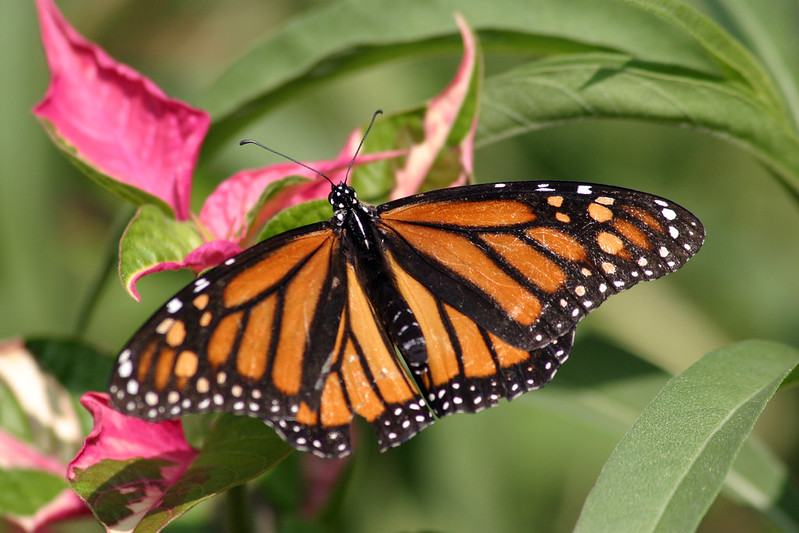By Mary Hightower
U of Arkansas System Division of Agriculture
Monarch butterflies are flitting their way around Arkansas and now is a good time to make these highly recognizable, but vulnerable, pollinators feel at home.
“The first batch of monarch caterpillars has emerged here at the Saline County Extension Office which is one of my favorite times of year,” said Nichole Nichols, Saline County extension agent for the University of Arkansas System Division of Agriculture.
The monarch butterfly has four distinct life stages: egg; caterpillar or larval stage; pupal stage in which it forms its chrysalis; and the familiar adult stage.
“The adults fly through the area in waves with the first generation starting around late March when they lay eggs for the second generation and so on until the fourth generation in September,” Nichols said. “The females can lay up to 400 eggs and they can take three to 12 days to hatch.”
Monarch larvae are very distinct, with their black, yellow, and white bands.
“After about two weeks the larva attaches itself to a twig and transforms into a pupa or chrysalis,” Nichols said. “Over another two weeks, the caterpillar transforms into the orange and black butterfly that we all recognize.”
She said most monarchs live for two to six weeks, except for those that migrate south for the winter. The monarch population east of the Rocky Mountains can fly nearly 2,500 miles from its northernmost reaches in Canada to its winter quarters in Mexico. It can take several generations to complete the return trip north.
Populations of monarchs declined in 1990s but stabilized in the mid-2010s.
The showy and familiar orange and black of the monarch butterfly. (U of A System Division of Agriculture photo by Kevin Quinn)
International Union for Conservation of Nature considers the monarch to be vulnerable to extinction, but not endangered. This was a change to its July 2022 assessment that added the butterfly to its “Red List of Endangered Species.”
Attracting monarchs
Nichols said attracting monarchs to the home garden and protecting them is easy.
The first step is to get the butterflies what they want and monarchs only eat milkweed.
“Females prefer common milkweed and swamp milkweed over other species for laying their eggs,” Nichols said. “Milkweed also contains toxins that make the monarchs poisonous to some predators that would eat them, they are not harmful to handle though.”
This will take some planning since milkweed seeds should be planted as soon as the threat of last frost is gone, she said. “You can scatter seeds over a prepared bed and water them well to get started.”
However, if you weren’t able to plan ahead, “you can also find started plants if it’s later in the spring,” Nichols said.
“Once the caterpillars emerge you can take a couple of extra steps to ensure their survival,” she said. “You can put a net over the plant to protect them from other flying insects. You can also get mesh habitats and bring them inside so you can watch the entire cycle from caterpillar to butterfly.
“Just make sure you have plenty of milkweed, some water, and sticks for them to form their chrysalis,” Nichols said. “Once the butterflies emerge and have properly dried out you can release them.”
For those interested in citizen science, Monarch Watch has a tagging program so the community at large can help build a better understanding of monarch behavior and populations.
Learn more about gardening for butterflies and other pollinators.
To learn about extension programs in Arkansas, contact your local Cooperative Extension Service agent or visit www.uaex.uada.edu. Follow us on X and Instagram at @AR_Extension. To learn more about Division of Agriculture research, visit the Arkansas Agricultural Experiment Station website: https://aaes.uada.edu. Follow on X at @ArkAgResearch. To learn more about the Division of Agriculture, visit https://uada.edu/. Follow us on X at @AgInArk.
About the Division of Agriculture
The University of Arkansas System Division of Agriculture’s mission is to strengthen agriculture, communities, and families by connecting trusted research to the adoption of best practices. Through the Agricultural Experiment Station and the Cooperative Extension Service, the Division of Agriculture conducts research and extension work within the nation’s historic land grant education system.
The Division of Agriculture is one of 20 entities within the University of Arkansas System. It has offices in all 75 counties in Arkansas and faculty on five system campuses.
The University of Arkansas System Division of Agriculture offers all its Extension and Research programs and services without regard to race, color, sex, gender identity, sexual orientation, national origin, religion, age, disability, marital or veteran status, genetic information, or any other legally protected status, and is an Affirmative Action/Equal Opportunity Employer.






